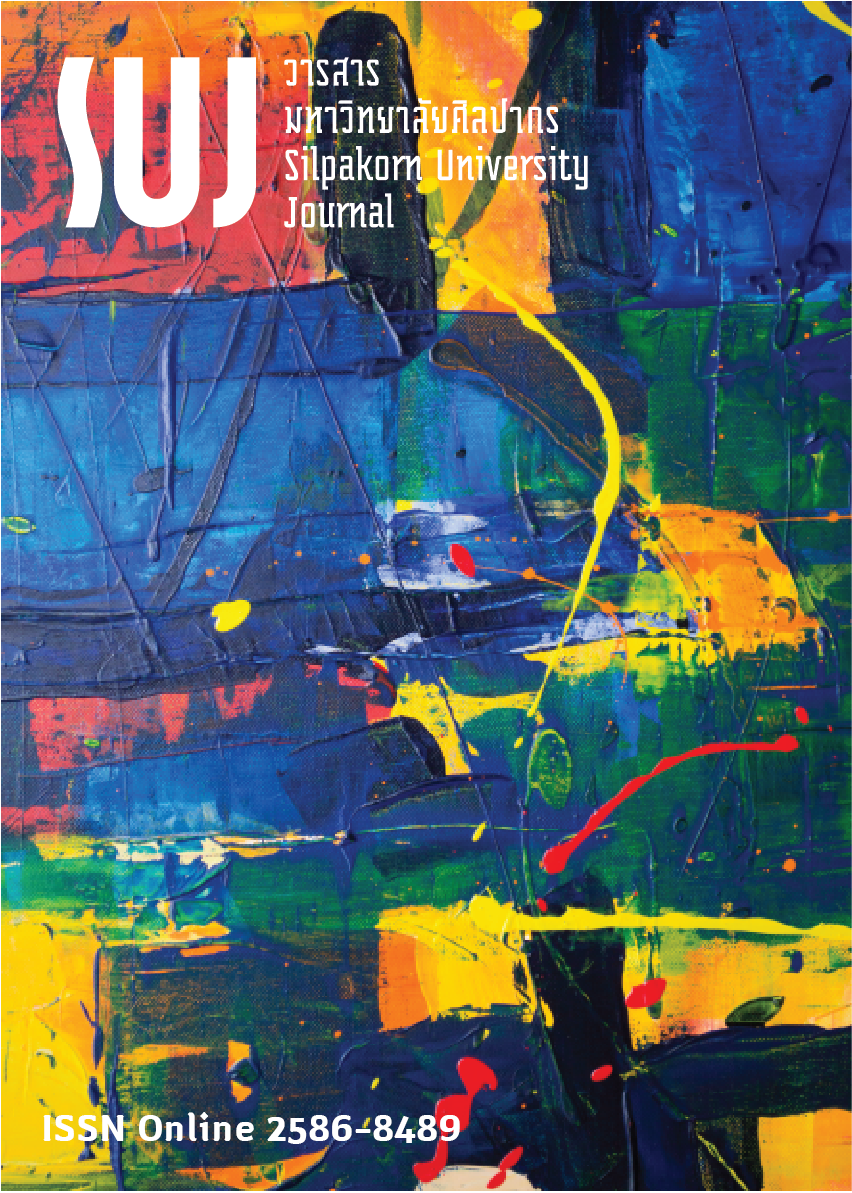นวัตกรรมวัสดุสิ่งทอทดแทนจากการสังเคราะห์ดินเพื่อสร้างสรรค์เครื่องนุ่งห่มแห่งอนาคตสู่ระบบนิเวศวิทยา (Textile substitute from synthesised soil to create future biological system friendly clothing)
Main Article Content
Abstract
สถานการณ์โรคระบาดส่งผลกระทบต่อมนุษย์ในเรื่องของสุขภาพ ความปลอดภัย และเศรษฐกิจของทุกประเทศทั่วโลกต้องหยุดชะงัก สำคัญที่สุด คือ ผลกระทบต่อวิถีการดำรงชีวิตของมนุษยชาติ พฤติกรรมกิจวัตรต้องถูกปรับเปลี่ยน การปฏิสัมพันธ์ระหว่างมนุษย์ด้วยกันสะท้อนให้เห็นถึงความคิดที่ย้อนแย้งที่มนุษย์พยายามเสาะแสวงหาความเจริญก้าวหน้าในวิทยาการทุก ๆ ด้าน โดยความเจริญอันไร้ขอบเขตเพียงเพื่อตอบสนองความต้องการของมนุษย์ แต่ผลิตภัณฑ์หรือสิ่งของเหล่านั้นกลับแฝงไปด้วยความเห็นแก่ตัว ก้าวล่วงธรรมชาติอันเป็นผลแห่งการทำลายสิ่งแวดล้อมอย่างรุนแรง ก่อเกิดมลภาวะที่เป็นพิษ และก้าวข้ามไปไกลจากความสมดุลของระบบนิเวศวิทยาของธรรมชาติ จึงเห็นได้ว่าวัตถุประสงค์ของผลงานวิจัย เรื่อง “นวัตกรรมวัสดุสิ่งทอทดแทนจากการสังเคราะห์ดินเพื่อสร้างสรรค์เครื่องนุ่งห่มแห่งอนาคตสู่ระบบนิเวศวิทยา” ผู้วิจัยได้นำดินที่เป็นสสารและมีจำนวนมากมายมหาศาลมาทำการสังเคราะห์เพื่อสร้างนวัตกรรมวัสดุสิ่งทอทดแทน กอปรกับดินประกอบด้วยแบคทีเรียชั้นดีที่มีสมบัติคล้ายคลึงกับเม็ดสีเมลานินอันบ่งบอกระดับค่าสีผิวพรรณของมนุษย์ ซึ่งเป็นผลให้นวัตกรรมวัสดุสิ่งทอทดแทนที่ได้มีความสัมพันธ์กันและสมดุลกัน อีกทั้งกระบวนการก่อเกิดที่ได้มาจากธรรมชาติสู่ผลิตภัณฑ์เพื่อประโยชน์ในการใช้สอย จนสุดท้ายคือหมดหน้าที่ของการใช้งานวัสดุทดแทนดังกล่าวพร้อมคืนกลับสู่ธรรมชาติ ผลผลิตแห่งนวัตกรรมนี้มุ่งเน้นให้มนุษย์แปรเปลี่ยนพฤติกรรมและตระหนักถึงแนวความคิดเรื่องการอนุรักษ์ รวมถึงการสร้างทัศนคติใหม่ต่อวงจรการสร้างสรรค์ผลิตภัณฑ์เพื่อตอบสนองความต้องการขั้นพื้นฐานของมนุษย์ โดยมุ่งเน้นการบูรณาการความรู้ด้านวิทยาศาสตร์และสะท้อนถึงปรัชญาสุนทรียศาสตร์เรื่องการเคารพตนเอง
The global pandemic continues to be the crisis over human’s health and safety. Such a crisis has halted the global economy, and, most importantly, it has caused big changes to our daily lives and our interactions between one another in a way that contradicts the greatest science advancement. Although humans have been making progress to create many science breakthroughs that would only serve their needs. Those outcomes have hidden away their selfishness, threatened the environment, destroyed Mother Nature. As a result, we are now witnessing the worst kind of pollution ever. However, this is not enough. We continue to cause disturbances to the ecosystem, making it lose its balance. Regarding this, the objective of this research entitled “Textile Substitute from Synthesised Soil to Create Future Biological System Friendly Clothing” is to find a way to alleviate the problem. The researcher applied a process to synthesize large volume of soil to create an innovated textile substitute. Soil is the material which contains good bacteria that resemble melanin pigment used in describing human skin colors. This knowledge suggested a potential answer to this research’s concern about environment that soil might serve as a seamless substitution. From the beginning, through to the use and to the final stage, this material has evolved but can eventually be returned to nature. All of these processes are not harmful to nature and its environment. The purpose of this innovation is to raise awareness and encourage humans to change their lifestyles and to be more concerned about the nature conservation. In addition, this innovation hope to bring a new perspective to the design, in which the scientific knowledge and the philosophy of aesthetics enhance each other and to hope that this will result in elevating people’s self-esteem.
Downloads
Article Details

This work is licensed under a Creative Commons Attribution-NonCommercial-NoDerivatives 4.0 International License.
References
Amal, A., Abeer, K., Samia, H., El-Nasser, A., & Nadia, H. (2011). Selection of Pigment (Melanin) Production in Streptomyces and their Application in Printing and Dyeing of Wool Fabrics. Research Journal of Chemical Sciences, 1(5): 22-28.
Australian Radiation Protection and Nuclear Safety Agency. (2017). Fitzpatrick Skin Type. [Online]. Retrieved November 30, 2019 from https://www.arpansa.gov.au/sites/default/files/legacy/pubs/RadiationProtection/FitzpatrickSkinType.pdf?acsf_files_redirect
Baic, M. (2016). From our Obsession. [Online]. Retrieved November 11, 2019 from https://qz.com/731893/a-designer-will-grow-alexander-mcqueens-skin-in-a-lab-to-use-for-leather-bags-and-jackets/
Brady, E. (2009). Environmental Aesthetics. In Callicott, J. B., & Frodeman, R. (Eds.), Encyclopedia of Environmental Ethics and Philosophy, (pp. 313-321). Detroit: Macmillan Reference USA.
Cecchini, C. (2017). Bioplastics Made from Upcycled Food Waste. Prospects for Their Use in the Field of Design. The Design Journal, 20(1): 1596-1610.
Drapers. (2020). Selfridges MD’s Radical ‘Project Earth’ Programme. [Online]. Retrieved August 17, 2020 from https://www.drapersonline.com/insight/analysis/selfridges-anne-pitcher-on-the-department-stores-radical-new-sustainability-initiative
McKinsey Global Institute. (2020). McKinsey COVID-19 Sustainability in Apparel Consumer Survey. [Online]. Retrieved May 30, 2020 from https://www.mckinsey.com/industries/retail/our-insights/survey-consumer-sentiment-on-sustainability-in-fashion
Philadelpheus, A. (1935). The Anavysos Kouros. The Annual of the British School at Athens, 36: 1-4.
Strohminger, N., Knobe, J., & Newman, G. (2017). The True Self: A Psychological Concept Distinct from the Self. Sage Journal, 12(4): 551-560.
The Business of Fashion and McKinsey & Company. (2020). The State of Fashion 2021. [Online]. Retrieved December 3, 2020 from https://www.mckinsey.com/industries/retail/our-insights/state-of-fashion
The Standard. (2019). Allbirds, A Startup from Silicon Valley with a Very Un-techy product - Shoes - has Made a Huge Impact. [Online]. Retrieved August 17, 2020 from https://thestandard.co/allbirds/
Women’s Wear Daily. (2020). Timberland Commits to Carbon Neutrality by 2030. [Online]. Retrieved September 1, 2020 from https://wwd.com/business-news/business-features/timberland-commits-carbon-neutrality-1234571910/


